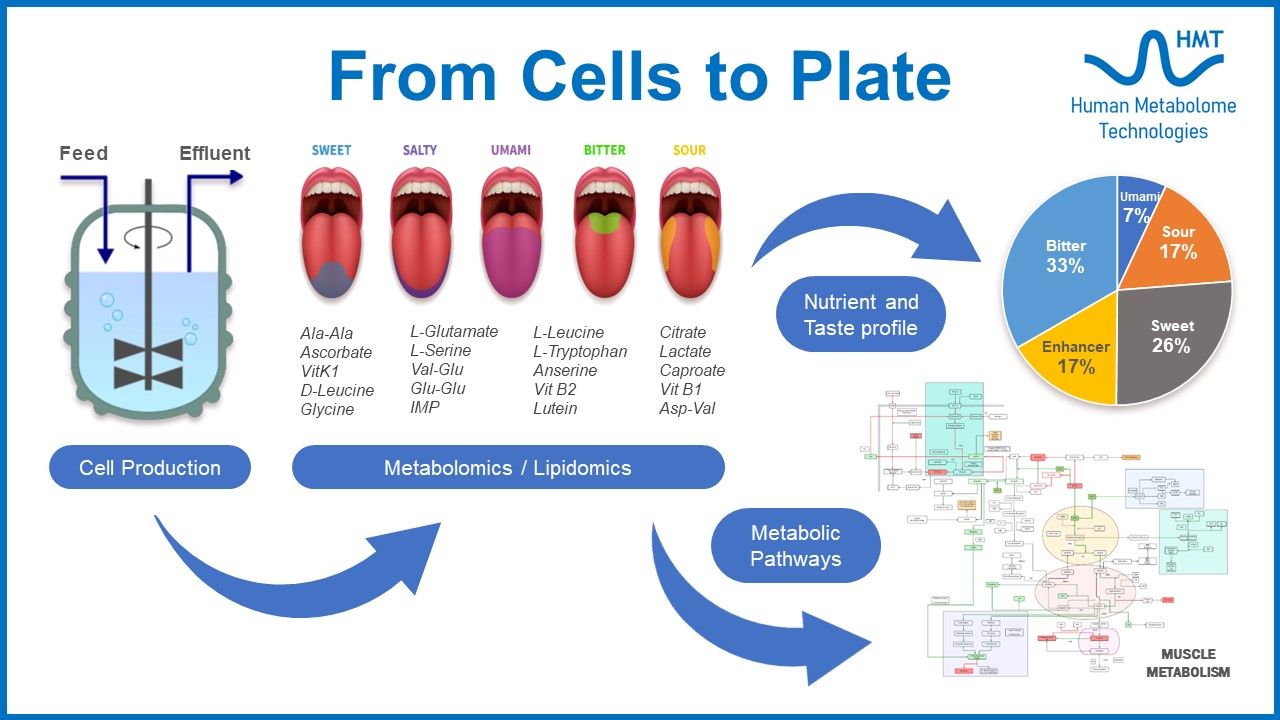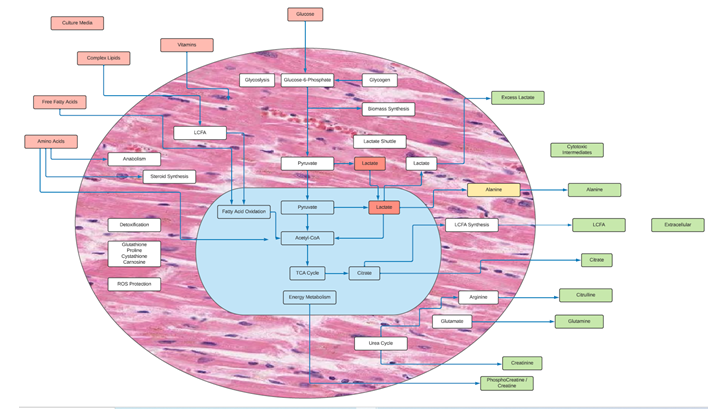Cellular Metabolomics and Optimizing Cultivated Meat Cell Line Selection

This article was written by and sponsored by Human Metabolome Technologies.
As the cultivated meat industry looks to scale production and come to market, it will be important for the field to learn more about the fundamental cellular pathways required for proper cell growth and cellular energy.
Since growing skeletal muscle-derived cells in cell cultures cannot fully reproduce the organization and function of living muscle tissues, understanding cellular metabolomics can play a key role in understanding the requirements to produce cultivated meat at a larger scale.
Cellular metabolomics provides a broad profile of hundreds of metabolites in cells and cell culture media. Metabolomics is a useful tool that can monitor cellular metabolism and lead to a better understanding of what may be required to optimize muscle cell growth and the nutritional content, texture, and taste of cell-based protein products.
Through this article, we look at how cellular metabolomics can help the cultivated meat industry identify and select cell lines suitable to scale production and meet the complexity of future food products.
Case Study: Cellular Metabolism and Skeletal Muscle Cells
Skeletal muscle cell metabolism is strictly regulated by substrate availability, the presence of oxygen, and energy demand, which in turn also regulates muscle protein metabolism and cell size.
Considering that different cell types may be co-cultured to produce cultivated meat, such as skeletal muscle cells, further research is needed to determine which specific cell types and properties influence the downstream production of cultivated meat and its nutrient profile.
To optimize the production of cultivated meat, companies will need to understand the underlying metabolism of muscle tissue; cellular metabolism can play a role in identifying the key factors.

For example, when considering the metabolism of skeletal muscle cells in cell culture, the cells’ genomic wiring may be set for active muscle metabolism, during which the cell cultures typically rely more on fatty acids than glucose for energy. This may need to be measured via cellular metabolomics to understand the state of the tissue and ensure that the cell-cultured muscle tissue for cultivated meat matches the metabolomic profile of conventional animal meat.
In addition, we can compare the nutrient profile of a wildtype animal tissue or product to the cell-based product (cells, media, tissues) to see how well the cultivated meat product matches the conventional product during production & development using only small amounts of material.
We can look at a piece of chicken, fish, or meat and measure its nutritional and taste benefits using a metabolic or nutrient profile. While macromolecules like carbohydrates and proteins are not directly measured, metabolomics can measure saturated fats, unsaturated fat (such as omega-3, omega-6, and omega-9 fatty acids), vitamins, essential fatty acids, essential amino acids, carotenes, flavonoids, and polyamines in cellular products and natural tissues.
In this way, we’re looking at the types of metabolites that provide the nutrient value of the wildtype animal, as well as taste elements, and compare them to the products in development.
Metabolomics as a Tool to Scale Cultivated Meat Production
For the cultivated meat industry to scale production, further research is needed to determine which cells will be best suited for large-scale manufacturing and the creation of specific product types based on their nutritional value, texture, and taste.
For example, the intrinsic cell characteristics, such as suitability for suspension growth, innate metabolism, cell differentiation, and genomic stability, will vary between cell types and impact which cell lines are optimal for large-scale production.

Considering how more cultivated meat players are looking to come to market, the process of studying and optimizing these intrinsic cell properties is time-consuming and challenging. Cellular metabolomics can help accelerate the process.
Cellular metabolomics can advance the development of cell lines suitable for cultivated meat. By better understanding the cell lines, cellular metabolomics can dramatically improve the efficiency and productivity of the production process of cell lines and influence product attributes, such as nutritional profile and taste.
Cellular Metabolism and the Future of Food
Furthermore, by managing and culturing cell lines in varying conditions, cellular metabolomics can help identify and yield cell lines adapted for various sets of conditions, such as large-scale production. This process can also yield cell lines exhibiting a new trait or metabolism geared for faster growth, more biomass, or other attributes.
At HMT, we offer a variety of Cellular Metabolomic Services to meet the complexity of developing future foods like cell-cultured meat. We provide targeted and untargeted assays to study the metabolomic pathways necessary for cell growth, biomass production, and cellular health.
HMT has platforms to measure both polar metabolites, such as in energy metabolism, nucleic acid production, and amino acid synthesis. We additionally provide lipid platforms to measure fatty acids, acyl glycerides, fat-soluble vitamins, and antioxidants.
This article was sponsored by Human Metabolome Technologies. For more information about Human Metabolome Technologies, please visit their website (en.humanmetabolome.com) to learn more or contact Dr. Alex Buko or Gina Johnson.
Photographs provided by Human Metabolome Technologies.
Stay connected with CellAgri
Join our mailing list to receive the latest news and updates weekly from the cellular agriculture industry. Your information will not be shared.





